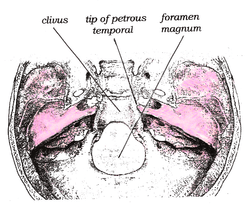Clivus (anatomy)
| Clivus (anatomy) | |
|---|---|
 | |
| Superior view of the clivus | |
 | |
| Longitudinal section of the head and neck showing the anatomical relation of the dens (labeled odontoid process of axis). Clivus is the inferior part of the slope at top left, the upper part of the slope belongs to the sphenoid bone. | |
| Latin | Clivus |
| Gray's | p.148 |
The clivus (Latin for "slope") is a part of the cranium, a shallow depression behind the dorsum sellæ that slopes obliquely backward. It forms a gradual sloping process at the anterior most portion of the basilar occipital bone at its junction with the sphenoid bone. On axial planes, it sits just posterior to the sphenoid sinuses. Just lateral to the clivus bilaterally is the foramen lacerum which contains the internal carotid artery, proximal to its anastamosis with the Circle of Willis. Posterior to the clivus is the basilar artery.
The pons sits on the clivus.
Clivus is also used as an abbreviated term for the clivus ocularis which is the sloping inner wall of the retina as it dips into the foveola in the macula of the eye.
Relation of the clivus and dens
The clivus is an important landmark for checking for anatomical atlanto-occipital alignment; the clivus, when viewed on a lateral C-spine X-ray, forms a line which, if extended, is known as Wackenheim's clivus line. Wackenheim's clivus line should pass through the dens of the axis or be tangential to it.[1]
See also
References
- ↑ McKenna DA, Roche CJ, Lee KW, Torreggiani WC, Duddalwar VA. Atlanto-occipital dislocation: case report and discussion. Can J Emerg Med 2006; 8(1):50-3. Available at: link and link. Accessed on: December 7, 2006.
Additional Images
-
Clivus
-
Clivus
External links
- Clivus at eMedicine Dictionary
- 22:os-0913 at the SUNY Downstate Medical Center - "Osteology of the Skull: Internal Surface of Skull"
- Diagram at uwo.ca
This article incorporates text from a public domain edition of Gray's Anatomy.
| ||||||||||||||||||||||||||||||||||||||||||||||||||||||||||||||||||||||||||

